
What are Hazardous Materials?
The average person doesn't realize that hazardous materials are common day-to-day items such as hairspray and laptops with lithium batteries. Here are six common categories of HAZMAT: flammable liquids, dry ice, lithium batteries, explosives, aerosols, and some beauty products. Learn why these products are hazardous in the shipping industry.
Did you know that many of the things we use in our day-to-day lives are hazardous materials? There's a lot more than you think. In just one day, you most likely have interacted with at least a dozen hazardous materials — these range from cleaning supplies to electronics that we use regularly.
Various government agencies regulate hazardous materials, including the U.S. Environmental Protection Agency (EPA), the U.S. Occupational Safety and Health Administration (OSHA), the U.S. Department of Transportation (DOT), and the U.S. Nuclear Regulatory Commission (NRC). Each organization has its own definition.
The DOT Regulates and Enforces the Safe Transportation of Hazardous Materials
In terms of transportation and shipping, we’ll focus on the DOT’s definition. It defines a hazardous material as “any item or chemical which, when being transported or moved in commerce, is a risk to public safety or the environment, and is regulated as such under its Pipeline and Hazardous Materials Safety Administration regulations, which includes the Hazardous Materials Regulations.”
It’s vital to identify if the product you’re shipping is a hazardous material; otherwise, the repercussions could be disastrous. In just this year, more than 16,000 incidents occurred involving hazardous materials resulting in over $60 million worth of damages, according to the DOT.
Six Common Hazardous Materials
Flammable Liquids
- Paints
- Wood stains
- Adhesives
Flammable liquids themselves don’t burn; it’s a mixture of their vapors and airs that burn. They’re classified as flammable because of their ignition point; they can catch fire and burn easily at normal or above normal working temperatures. Even at normal room temperatures, flammable liquids can release enough vapor to form burnable mixtures with air. Flammable liquid fires burn very fast, and they give off a lot of heat with thick, toxic smoke.
Dry Ice
- Food, medical, or other perishable shipments containing dry ice
Dry ice is solid carbon dioxide that release carbon dioxide gas as it cools. Shipments containing dry ice must be packaged securely that allows the carbon dioxide gas to be released. The package could burst from the pressure of locked-in gas, therefore, potentially damaging its contents and other shipments around it.
Lithium Batteries
- Portable chargers
- Laptops
- Cell phones
These lithium-based batteries are generally lightweight, inexpensive, and environmentally safer than alternatives. They are, however, associated with fire and explosion risk because they generate large amounts of energy. Batteries and devices are required to be packaged carefully to avoid shifting within the package, accidental activation of the device, and short circuiting.
Explosives
- Fireworks
- Ammunition
- Gun powder
This category is self-explanatory. There is a fire and explosion risk associated with shipping these products; therefore, the products must be packaged and labeled carefully so that everyone involved in the shipping process knows how to handle the package.
Aerosols
- Cleaners
- Hairspray
- Insect repellents
Aerosols are pressurized containers that hold compressed gases that expel liquids or powders from the container. They are a HAZMAT because of either its contents or its flammable propellant, or both. Some states even include empty aerosol containers as part of their Universal Wastes list.
Beauty Products
- Fragrances
- Nail polish and nail polish remover
- Alcohols (e.g. mouthwashes, antiseptics, etc.)
These everyday consumer products may seem harmless, but they can be toxic and explosive if handled incorrectly. Consumer products generally have lower concentrations of hazardous chemicals but that depends on the individual brands.
What’s Integral for Safely Shipping Hazardous Materials?
The most important part of shipping hazardous materials is before the shipping itself: the packaging, in which the hazardous materials must be accurately identified, correctly labeled, and clearly communicated.
Check the Safety Data Sheet that is prepared by the manufacturers to determine how to classify your product if it’s HAZMAT. According to the DOT, about 1,500 accidents transportation accidents occur when undeclared hazardous materials are shipped each year.
For more information on shipping HAZMAT, check out our Guide to Shipping Hazardous Materials.




